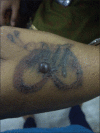Efficacy of the Q-switched Neodymium: Yttrium Aluminum Garnet Laser in the Treatment of Blue-black Amateur and Professional Tattoos
- PMID: 26677271
- PMCID: PMC4681196
- DOI: 10.4103/0019-5154.169129
Efficacy of the Q-switched Neodymium: Yttrium Aluminum Garnet Laser in the Treatment of Blue-black Amateur and Professional Tattoos
Abstract
Background: Q-switched neodymium: yttrium aluminum garnet (Nd: YAG) laser at a wavelength of 1064 nm primarily targets dermal melanin and black tattoo ink. Recent studies have shown that this laser is effective in treating black tattoos. There are few studies conducted in India for the same.
Aim: The aim was to assess the effectiveness of Q-switched Nd: YAG laser (QSNYL) in the treatment of blue-black tattoos following 3 treatment sessions.
Materials and methods: This study, a prospective interventional study included a total of 12 blue-black tattoos. Following informed consent for the procedure, as well as for photographs, a questionnaire was administered, and improvement perceived by the patient was recorded. In addition, global assessment score (GAS) by a blinded physician was also recorded. Photographs were taken at baseline and at every follow-up. Each patient underwent three treatment sessions with 1064 nm QSNYL at 4-6 weekly intervals. Fluences ranged from 1.8 to 9 J/cm(2). The follow-up was done monthly for 4 months from the first treatment session. The response was assessed by patient assessment (PA) and GAS by comparing photographs.
Results: After three treatment sessions, although no patient achieved clearance, most patients showed good response with few adverse effects. An average of 64.1% (GAS) and 54.2% (PA) improvement was observed in 12 tattoos. Tattoos more than 10-year-old showed quicker clearing than those less than 10-year-old. Amateur tattoos also showed a better response in comparison to professional tattoos.
Conclusion: Totally, 1064 nm QSNYL is safe and effective for lightening blue-black tattoos in pigmented Indian skin. All patients achieved near complete clearance following the continuation of treatment (an average of six sessions) although this was spaced at longer intervals.
Keywords: Blue-black tattoos; Q-switched neodymium:yttrium aluminum garnet laser; pigmented skin.
Conflict of interest statement
Figures





Similar articles
-
The Q-switched Nd:YAG laser effectively treats tattoos. A controlled, dose-response study.Arch Dermatol. 1993 Aug;129(8):971-8. Arch Dermatol. 1993. PMID: 8352621 Clinical Trial.
-
Successful Treatment of Cosmetic Eyebrow Tattoos in Fitzpatrick III-IV With Picosecond (1,064, 532-nm) Neodymium-Doped Yttrium Aluminum Garnet Laser With a Perfluorodecalin-Infused Patch: A Pilot Study.Lasers Surg Med. 2020 Sep;52(7):586-589. doi: 10.1002/lsm.23189. Epub 2019 Dec 11. Lasers Surg Med. 2020. PMID: 31828826
-
A split-tattoo randomized Q-switched neodymium-doped yttrium-aluminium-garnet laser trial comparing the efficacy of a novel three-pass, one-session method with a conventional method in the treatment of blue/black tattoos in darker skin types.Clin Exp Dermatol. 2022 Jan;47(1):125-128. doi: 10.1111/ced.14827. Epub 2021 Sep 2. Clin Exp Dermatol. 2022. PMID: 34236705 Clinical Trial.
-
Laser removal of tattoos.Am J Clin Dermatol. 2001;2(1):21-5. doi: 10.2165/00128071-200102010-00004. Am J Clin Dermatol. 2001. PMID: 11702617 Review.
-
Immediate cutaneous hypersensitivity after treatment of tattoo with Nd:YAG laser: a case report and review of the literature.Ann Allergy Asthma Immunol. 2002 Aug;89(2):215-7. doi: 10.1016/S1081-1206(10)61942-4. Ann Allergy Asthma Immunol. 2002. PMID: 12197582 Review.
References
-
- Tanzi EL, Lupton JR, Alster TS. Lasers in dermatology: Four decades of progress. J Am Acad Dermatol. 2003;49:1–31. - PubMed
-
- Kilmer SL, Lee MS, Grevelink JM, Flotte TJ, Anderson RR. The Q-switched Nd: YAG laser effectively treats tattoos. A controlled, dose-response study. Arch Dermatol. 1993;129:971–8. - PubMed
-
- Jones A, Roddey P, Orengo I, Rosen T. The Q-switched ND: YAG laser effectively treats tattoos in darkly pigmented skin. Dermatol Surg. 1996;22:999–1001. - PubMed
-
- Sardana K, Garg VK, Bansal S, Goel K. A promising split-lesion technique for rapid tattoo removal using a novel sequential approach of a single sitting of pulsed CO (2) followed by Q-switched Nd: YAG laser (1064 nm) J Cosmet Dermatol. 2013;12:296–305. - PubMed
LinkOut - more resources
Full Text Sources
Other Literature Sources
